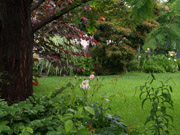
Features
Agronomy
Understanding the importance of turfgrass selection and the benefits of overseeding
May 6, 2011 By Mike Jiggens
By Rachel Carson & Karl Fiander, Plant Products Co. Ltd.
Turfgrass selection is perhaps the most important part in developing
and maintaining a healthy and vigorous turf stand. There are many
choices available today and the planning process cannot be
underestimated.
Over the years, plant breeders have made significant advancements in the development of cultivars within cool season species like Kentucky bluegrass, perennial ryegrass, fine fescue and tall fescue. During this time, seed companies have consistently released varieties with improved growth characteristics, turf quality, resistance to drought, insects and disease and other important benefits. Deciding which variety or varieties are right for the job at hand can be a difficult task.
Overseeding is the practice of planting grass seed directly into existing turf. It is an economical way to fill in bare spots, establish improved grass varieties, and improve turf density and colour.
There are two distinct advantages of overseeding. First, overseeding turf compensates for the natural slowdown of turf growth. Turfgrass has a life span of approximately five to10 years, dependent on turf management conditions. During the latter part of the lifecycle, the turfgrass plant reduces the amount of new grass blades being produced. This causes the turf to be more susceptible to disease, damage from traffic and weeds. Overseeded turf will stay greener and look thicker and healthier.
The second advantage of overseeding is the improved disease resistance. Today’s new turfgrass seed varieties have improved disease resistance compared to older established seed varieties. Overseeded turf will have improved disease tolerance.
In wading through the decision-making process for overseeding, it is important to review all the elements in which the turf has to perform. It is important to evaluate environmental factors such as turf use, i.e. sports field, golf, lawn and soil type, i.e. sand or soil. Considering maintenance budgets and other inputs, such as fertilizers and pesticides, is also essential.
Perennial ryegrass is an economical choice for overseeding. Alternatively, mixtures with a high percentage of perennial ryegrass are also excellent choices. Both provide fast establishment, wear tolerance and competitiveness with existing grasses in the sward. In overseeding operations, this will reduce opportunities for failure.
Fine fescue and bluegrass can be incorporated into perennial ryegrasses mixtures to improve the colour, texture and cold tolerance of overseeded turf. Fine fescue is desirable because of its fine upright texture and good shade tolerance. Kentucky bluegrasses are also commonly incorporated in overseeding mixtures. Bluegrasses provide a dark green colour and have excellent cold and wear tolerance. Creeping bentgrasses are often overseeded alone or in combination with a fine fescue to improve fine turf on golf courses.
The site must be prepared in advance for successful overseeding to occur. The turf must be mowed at the lowest possible height and all clippings removed. Thatch and debris can be removed by either a rake or verticutting machine. A properly prepared site that has been mowed, dethatched and aerated will have the highest chance of quick establishment. It is essential that the seed has contact with the soil for germination to occur. Even distribution can be attained by spreading the seed mixture in several directions. Irrigation is critical during the establishment of overseeded turf, but overwatering should be avoided. The site must be watered lightly for several days to move the seeds into the soil and keep it moist. A light watering two times per day for seven to 10 days is ideal. After emergence, the watering frequency can be transitioned into the regular irrigation schedule.
Another important factor to establishing a fast, dense cover of overseeded turf is the seeding rate. The seeding rate for overseeding is approximately half the new planting seeding rate, however, dependent on the site conditions, the rate could vary. Recent studies have shown that heavy overseeding (up to three times standard rates) applied two to three times per year has a significant impact on reducing weed invasion.
Mowing, irrigation, fertilization and pest management are all critical to the successful establishment of newly overseeded turf. During establishment, mowing height can be raised for two weeks after planting to help develop a fast cover. Newly overseeded sites should neither be kept wet nor excessively dry. This is most critical during the first several weeks after planting during establishment.
Fertilize the overseeded sites with a complete fertilizer at a rate of one pound of nitrogen per 1,000 square feet. The fertilizer should be applied immediately after seeding to prevent phytotoxicity to the young seedlings. After emergence, light applications of nitrogen will encourage dense, healthy stands of turf.
In summary, choosing the right turfgrass seed mixture for overseeding is a key component of maintaining thick and healthy turf. As the lifecycle of the turfgrass plant is waning, new varieties are introduced which improve performance and appearance. The right seed mixture adapted to the site, along with proper planting, can be an economical method of maintaining superior turf.
Print this page